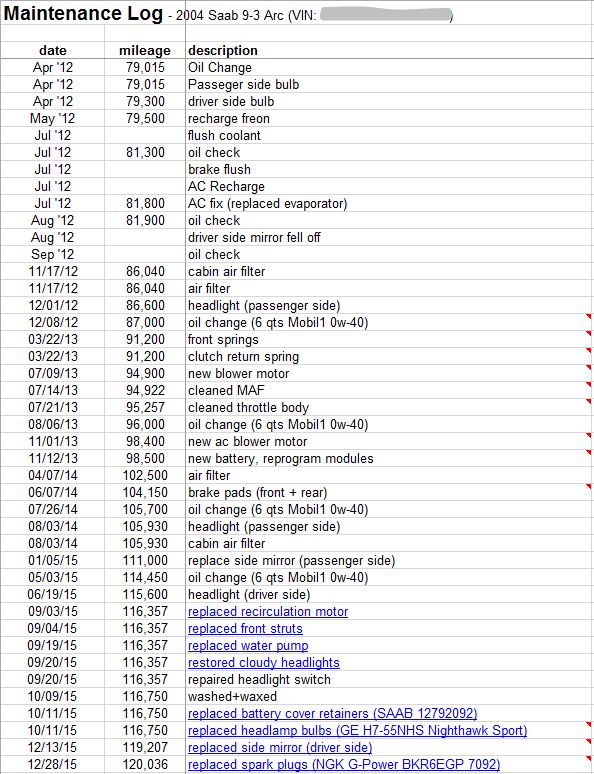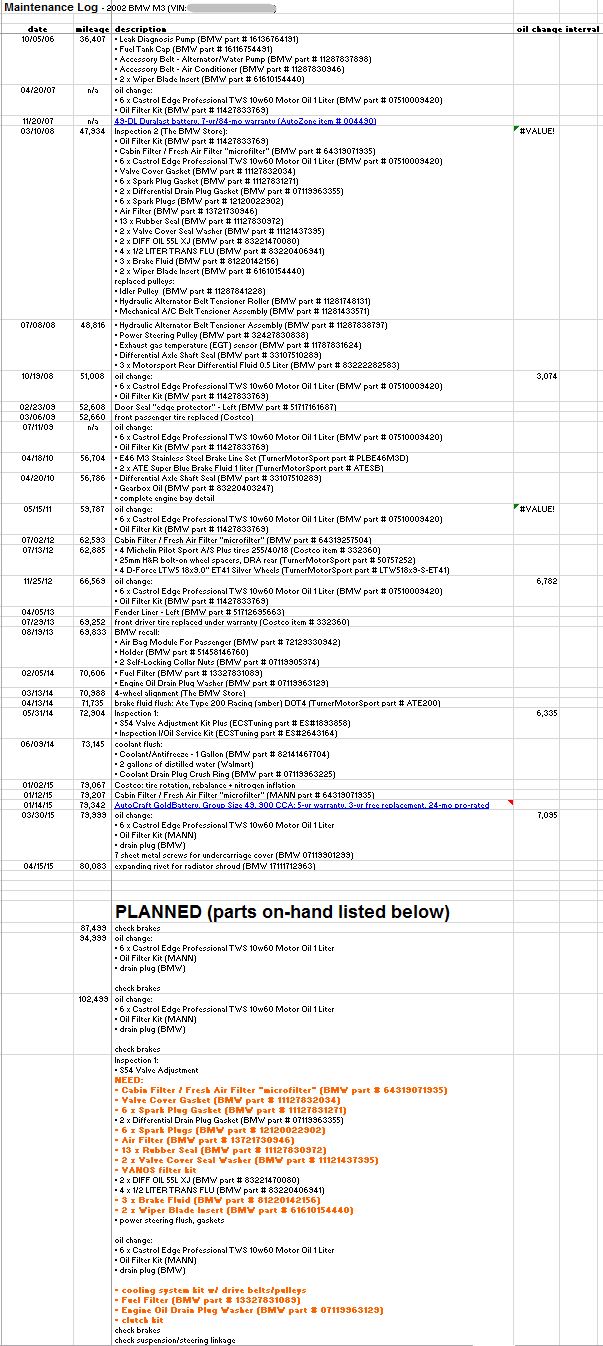A vehicle maintenance log is incredibly valuable and doesn’t take much to set up. Benefits include:
- Easy tracking of completed work to avoid costly duplication or missing important service
- Easy reference to dates, mileage, parts used, costs, etc
- Typically increases the private-party value of your car as the buyer will see how disciplined you were in the car’s maintenance + upkeep
Here’s a screenshot of a Saab 9-3 maintenance log where I’ve integrated completed work from the previous owner prior to 116k miles:

Different methods I’ve used and what I’ve learned from them:
I have evolved over the years to my current state of primarily using a spreadsheet which I’ll showcase in this DIY, but you can choose to do something different. There is no perfect solution for everyone so just having something that works for you is way better than not tracking at all.
There have been pros + cons in the different methods I’ve tried. Below I start in chronological order and highlight was I use today:

As I highlight above, my current approach includes a local spreadsheet (Microsoft Excel) and a hanging file folder to keep paperwork in case I need to reference it later. Since my day job involves having a computer available most of the time I usually have access to my maintenance log via a local spreadsheet, whether at home or on the road.
Let me explain why I currently have 2 methods. A spreadsheet allows me to easily reference past work and serves as a guide in where to look for paperwork stored in a file folder. I track multiple cars so I have a tab created in the spreadsheet and a separate file folder for each car.
I haven’t yet tried migrating to an online spreadsheet but the idea of accessing a maintenance log from my smartphone is very appealing. A friend of mine showed me his by simply sharing his Google Docs spreadsheet with me. I need to get over the design formatting I’ve gotten used to with Microsoft Excel but I believe this is just resistance to change! At one point I’ve tried copying + pasting from my local spreadsheet to an online spreadsheet as a quick test so I know the transition will eventually happen at some point.
Use spreadsheet formatting to your advantage:
Let’s start with another example and break down how formatting helps to keep things organized and easy to reference. Below is a screenshot of a BMW M3 maintenance log which is a bit more detailed than the previous example:

A few formatting features to call out:
- Fonts, bold + sizes: It helps to visually separate section titles, column names, etc.
- Freeze panes: I can easily lock the top row and the first two columns to always be within view no matter where I’m scrolling on the spreadsheet. It helps to keep visual reference to the car I’m looking at with the VIN # easily referenced along with service dates + mileage.
- Columns versus rows: I’m used to reading things in chronological order from top to bottom so this was a no-brainer for me. I can easily widen columns so the information fits better to minimize vertical scrolling and can alway add new columns such as cost if I ever decide to track a car’s lifetime expense.
- Hyperlinks: It’s helpful to reference links to parts used or references such as FCP’s DIY blog if I need to revisit the work. I need to be more consistent with this but it’s slowly proving to be helpful than not. At a minimum it’s really insightful to have than not.
- Color-coding: This puts my eyes where work needs to be done. Above I used a color to signify parts I don’t yet have which also helps to keep an inventory of what I do have.
- Sections: Future work is pre-planned at the bottom while completed work is at the top. This is personal preference but you can choose to do things differently since spreadsheets are highly customizable!
- Inserting comments: I’m used to including notes as inserted comments for the cell summarizing the work. This typically includes order details for parts. I’m not as consistent with this but it’s becoming more of a habit lately as it’s also proving to be helpful than not.
- Bullet lists: While it’s not a native feature to have a bullet list in a cell, I manually do this by inserting asterisks to help visually digest past details more easily.
- Calculations: This is a new feature I’ve been recently testing, hence it’s the right-most column that was recently added. In the example above I wanted to visually see how long my oil change mileage intervals were by taking the difference of the second column’s mileage during the days where the oil was changed. There are a few calculation errors as I seem to have missed certain mileage inputs on some days but it wasn’t critical to track down so I let that go.
I haven’t yet geeked out with graphs or data modeling but that’s probably something I’d try if I had a LOT of free time (ie. retirement). Hope this helps provide you with options for setting up and keeping a vehicle maintenance log. You can choose to keep it super simple, go all out with structured details or anywhere in between!











